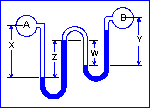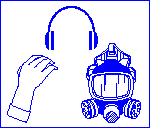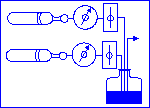INDUSTRIAL HYGIENE
Industrial hygiene is defined as the recognition, evaluation, and control of workplace hazards. Its origins are based on limiting personal exposures to chemicals, and have evolved to address the control of most other workplace hazards including over-exposure to noise, heat, vibration, and repetitive motion.
 Occupational exposure to chemicals is still considered one of the most wide spread hazards in industry. The use of engineering controls is the preferred method of limiting these exposures. Dilution and capture ventilation are two important methods to control occupational exposure. The design and position of hoods and vents, and amount of air infiltration can substantially change exposure conditions. Material Safety Data Sheets and other documentation provide a basis for predicting adverse effects, disposal needs, and fire and ignition concerns.
Occupational exposure to chemicals is still considered one of the most wide spread hazards in industry. The use of engineering controls is the preferred method of limiting these exposures. Dilution and capture ventilation are two important methods to control occupational exposure. The design and position of hoods and vents, and amount of air infiltration can substantially change exposure conditions. Material Safety Data Sheets and other documentation provide a basis for predicting adverse effects, disposal needs, and fire and ignition concerns. Sampling and monitoring equipment is available to quantify exposures to contaminants, noise, radiation, and heat. Correct sampling strategy and interpretation are essential elements of an industrial hygiene survey. Confined spaces, ventilation changes, the performance of collection systems, and pressure relief valves are all items of concern for exposure evaluation.
Sampling and monitoring equipment is available to quantify exposures to contaminants, noise, radiation, and heat. Correct sampling strategy and interpretation are essential elements of an industrial hygiene survey. Confined spaces, ventilation changes, the performance of collection systems, and pressure relief valves are all items of concern for exposure evaluation. The selection of appropriate personal protective equipment for exposure control often requires both an understanding of the limitations of the equipment, and the expected exposure parameters as determined by an industrial hygiene evaluation. Engineering controls are considered the preferred method of control, but personal protective equipment plays an important role for health, safety, and rescue, especially when using confined space entry procedures. The potential for misuse or misapplication of these devices should be evaluated.
The selection of appropriate personal protective equipment for exposure control often requires both an understanding of the limitations of the equipment, and the expected exposure parameters as determined by an industrial hygiene evaluation. Engineering controls are considered the preferred method of control, but personal protective equipment plays an important role for health, safety, and rescue, especially when using confined space entry procedures. The potential for misuse or misapplication of these devices should be evaluated. The Occupational Safety and Health Administration, the American Conference of Governmental Industrial Hygienists, and the National Institute of Occupational Safety and Health are three organizations which establish many of the rules governing allowable workplace exposures. Permissible exposure limits for noise, chemicals, heat, and other workplace stressors have been established and often include safety factors.
The Occupational Safety and Health Administration, the American Conference of Governmental Industrial Hygienists, and the National Institute of Occupational Safety and Health are three organizations which establish many of the rules governing allowable workplace exposures. Permissible exposure limits for noise, chemicals, heat, and other workplace stressors have been established and often include safety factors.